SS Camorta
.jpg) | |
| History | |
|---|---|
| Name: | SS Camorta |
| Owner: | British India Steam Navigation Company |
| Builder: | Pointhouse yard of A. & J. Inglis, Glasgow |
| Yard number: | 160 |
| Launched: | 16 November 1880 |
| Fate: | Sank 6 May 1902 |
| General characteristics | |
| Tonnage: | 2119 grt |
| Length: | 285.2 feet |
| Beam: | 35.2 feet |
| Draught: | 24.1 feet |
| Installed power: | 201 nhp |
| Propulsion: | steam, compound engines |

SS Camorta was a passenger steamship built at A. & J. Inglis in 1880 and owned by the British India Steam Navigation Company.[1]
Fate
Camorta sank in the Irrawaddy Delta on 6 May 1902 with the loss of all 655 passengers and 82 crew.[2] [3] She was en route from Madras, India, to Rangoon, Burma, across the Bay of Bengal, when she was caught in a cyclone while crossing an area called the Baragua Flats, just off the Irrawaddy Delta. All of her passengers and 73 of her crew were Indians. She was reported missing when she failed to arrive at Rangoon on 13 May 1902. Other British India vessels were sent to search for her. Initially a lifeboat was found near the Krishna lightvessel.[4] The wreck was subsequently found by SS Purnea on 4 June 1902 in fifteen fathoms (90 feet; 27 meters) of water; her masts still stood six feet (1.8 meters) above the water. The disaster was the fourth worst loss of life in the wreck of a British-registered civilian vessel (she was registered in Glasgow, Scotland) in history after RMS Titanic in 1912, RMS Lusitania in 1915, and RMS Empress of Ireland in 1914.
References
- ↑ Shipping Times: Built in 1880 - SS Camorta
- ↑ "Shipping Disasters", The Times, 15 May 1902
- ↑ "Shipping Disaster", The Times, 5 June 1902
- ↑ SS Camorta